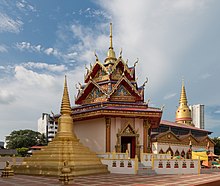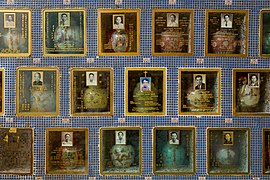ဝက်ချရယန့်ကလာရမ်
ပုံပန်းသွင်ပြင်
| Wat Chayamangkalaram วัดไชยมังคลาราม | |
|---|---|
 Front view of the temple | |
| အချက်အလက်များ | |
| တည်နေရာ | Pulau Tikus |
| ကိုဩဒိနိတ် | 5°25′54.479″N 100°18′48.276″E / 5.43179972°N 100.31341000°Eကိုဩဒိနိတ်: 5°25′54.479″N 100°18′48.276″E / 5.43179972°N 100.31341000°E |
| ဘာသာရေး နှီးနွယ်မှု | ဗုဒ္ဓဘာသာ |
| ခရိုင် | Northeast Penang Island District |
| ပြည်နယ် | Penang |
| နိုင်ငံ | မလေးရှားနိုင်ငံ |
| ဗိသုကာ | |
| ဗိသုကာ အမျိုးအစား | Thai temple |
| တည်ထောင်သူ | Phra Phorthan Kuad[၁][၂] |
| စတင်သည့်နှစ် | 1845[၁][၂][၃] |
ဝက်ချရယန့်ကလာရမ် (ထိုင်း: วัดไชยมังคลาราม; RTGS: Wat Chaiyamangkhalaram) သည် မလေးရှားနိုင်ငံ၊ ပီနန်မြို့နယ်၊ ဂျော့မြို့၏ Pulau Tikus ဆင်ခြေဖုံးအရပ်တွင် တည်ရှိသည့် ထိုင်းကျောင်းတော်တစ်ခု ဖြစ်သည်။ ၎င်းသည် Kelawei လမ်းမပေါ်တွင် တည်ရှိကာ ဓမ္မိကာရာမမြန်မာကျောင်းတော်နှင့် နီးသည်။ ဤကျောင်းတော်သည် နိုင်ငံတွင် သက်တမ်းအကြာဆုံး ထိုင်းမလေးရှား ကျောင်းတော် ဖြစ်သည်။ ကျောင်းတော်သည် နှစ်စဉ်ကျင်းပမြဲဖြစ်သည့် ကဆုန်လပြည့်နေ့နှင့် နှစ်စဉ်ကျင်းပသည့် ထိုင်းတို့၏ Songkran နှင့် Loi Krathong စသည့်ပွဲတော်များကျင်းပရာနေရာလည်း ဖြစ်သည်။[၄][၅][၆]
သမိုင်းကြောင်း
[ပြင်ဆင်ရန်]ရုပ်ပုံ
[ပြင်ဆင်ရန်]-
The temple stupa structure, c. 1900
-
Reclining Buddha statue inside the temple which is considered as one of the world's longest.
-
Statue of Devas guarding the temple.
-
Urns where the cremated are being housed.
ပြင်ပလင့်များ
[ပြင်ဆင်ရန်]- ↑ ၁.၀ ၁.၁ Khoo Salma Nasution (2012). "Exploring Shared History, Preserving Shared Heritage: Penang's Links to a Siamese Past The Siamese community and Buddhism in Penang". Journal of the Siam Society 100. Siamese Heritage. “The site of the Pulau Tikus Siamese Temple, the oldest Siamese temple in Penang, was cleared in 1795 and a Burmese temple was established there since the early nineteenth century. Around 1830, the Siamese and Burmese community totalled 648 out of a population of about forty thousand. In 1845, during the term of W. J. Butterworth as governor of the Straits Settlements, the East India Company made a grant of land to the Burmese and Siamese inhabitants to be jointly held by Nongmay and Boonkhan as representatives of the Burmese community, and Nankayo and Boonsoon as representatives of the Siamese community. The first head priest was Phra Kuad. Inscriptions showed that the building of the temple had been largely due to the philanthropic efforts of Chinese Buddhists. This temple was renamed Wat Chaiya Mangkalaram in 1948, and its famous Reclining Buddha statue was unveiled by the Thai king and queen before a crowd of 5,000 during their official trip to Malaya in 1962.” Archived 23 March 2019 at the Wayback Machine.
- ↑ ၂.၀ ၂.၁ A Tale of Three Temples – The Temples of Pulau Tikus။ Penang Free Sheet။ 23 March 2019 တွင် မူရင်းအား မော်ကွန်းတင်ပြီး။ 23 March 2019 တွင် ပြန်စစ်ပြီး။ “Across the street, closer than a stone's throw away, is the Wat Chayamangkalaram. Much like its Burmese neighbour, the temple is a feast of colours – particularly gold. Queen Victoria first granted the land to the Buddhist community in 1845 to promote trade between the British Empire and Siam. A thing of beauty, if not dominance, the reclining Buddha is the temple's centrepiece and main place of worship. However, as well as serving as a stunning backdrop for people praying and burning incense, it also serves as columbarium. A visitor can walk completely around the statue and, at the back of the statue, can view where the urns of the cremated are housed. One thing to notice when visiting the temple is the offerings made at different shrines. Of note, you can sometimes find a bowl of laksa sitting at the base of a shrine. It is not unusual for offerings of food to appear at Buddhist places of worship, but laksa supposedly has a specific relevance. The first monk in Wat Chaiyamangkalaram was Phorthan Kuat, a Theravada Buddhist monk from Siam also known as the 'Powerful Monk'. It is said that he was very fond of asam laksa and, to this day, the famous local dish is still offered to his shrine by devotees.”
- ↑ Buddhist temples in Penang။ New Straits Times (24 May 2018)။ 24 March 2019 တွင် ပြန်စစ်ပြီး။
- ↑ Joshua Eliot; Jane Bickersteth (2002)။ Malaysia Handbook: The Travel Guide။ Footprint Handbooks။ p. 160။ ISBN 978-1-903471-27-2။
- ↑ Arnold Loh (14 April 2015)။ Water Festival celebrations off to a soaking start at Burmese Buddhist temples။ The Star။ 23 March 2019 တွင် ပြန်စစ်ပြီး။ “Revellers at the Water Festival "fired" at visitors with their water guns at the Wat Chayamangkalaram and Dhammakirama Burmese Buddhist temples in Burma Lane, where the three day celebrations began yesterday.”
- ↑ Five million Malaysians celebrate Songkran and Good Friday။ The Sun (13 April 2017)။ 23 March 2019 တွင် ပြန်စစ်ပြီး။ “Hundreds of revellers thronged Wat Chayamangkalaram in Pulau Tikus here to usher in the Thai New Year or more popularly known as Songkran.”





